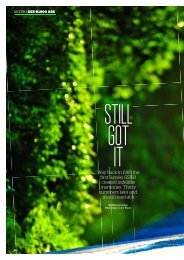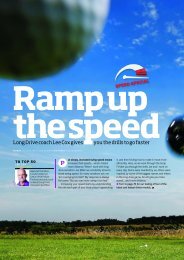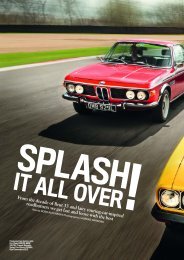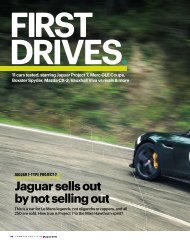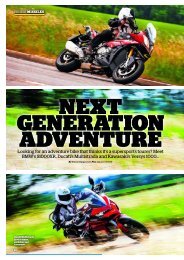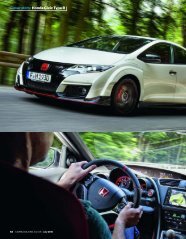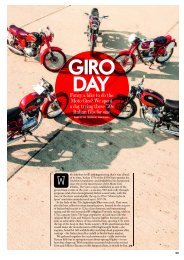Comeback kings
You also want an ePaper? Increase the reach of your titles
YUMPU automatically turns print PDFs into web optimized ePapers that Google loves.
B<br />
BIMOTA TESI 3D<br />
<strong>Comeback</strong><br />
<strong>kings</strong><br />
Legendary Italian brand Bimota are back in the<br />
UK with a new importer and revitalised range.<br />
The radical Tesi 3D Naked heads the charge<br />
By John Westlake Pics Chippy<br />
28
2015 BIKES RIDDEN<br />
est pick of all the current Bimotas, the new Tesi 3D<br />
Naked genuinely makes sense. If you’re going to<br />
spend £25,450 on a new motorcycle, you might as<br />
well have one that is fundamentally different to<br />
every other bike on the road, one that embodies an<br />
engineering leap of faith that’s arguably greater than<br />
anything from a bike manufacturer in the last 30 years.<br />
Bimota’s new BB3, for example, is no doubt an astonishing<br />
thing to ride, but it’s essentially an S1000RR with knobs on (or<br />
indeed nobs on, depending on your view of the owners). But the<br />
Tesi, thanks to its hub-centred front end and omega chassis, is<br />
something you cannot buy from a mainstream manufacturer. It is<br />
unequivocally special.<br />
And it’s clear where that money has been spent. The frame –<br />
each side milled from a 100kg lump of aluminum – is the<br />
centrepiece, with the trellis front and rear swingarms looking<br />
more like art than structural components. Peer closer and it’s a<br />
blizzard of CNC machined porn. Every linkage, lever, bracket and<br />
footrest has been hewn from solid billet. Casting and forging are<br />
for the lower orders.<br />
And in contrast to the old Tesi 2D, where the bodywork<br />
appeared curiously unfinished, with exposed air intakes<br />
disrupting the bike’s lines, the 3D looks slick, resolved and tidy.<br />
There’s no hint it was designed and built by a company with fewer<br />
employees than a small McDonald’s.<br />
The only mildly disappointing aspect is you can’t see much of<br />
the really clever bits. By its nature the fiendishly complex hub is<br />
obscured by the brake discs, and all but one of the rods that<br />
transfer the steering input from handlebars to hub are hidden by<br />
the half-fairing. All you can see of the steering mechanism is the<br />
rod and lever on the left hand side.<br />
So what’s new with the Tesi 3D Naked? Well, it’s no more naked<br />
than previous models – the name is to differentiate it from the<br />
Anniversary model which has more carbon fibre – so it looks<br />
largely similar to its predecessor the Tesi 3D Evo.<br />
The obvious difference is the pillion seat that Bimota say was<br />
requested by potential owners who wanted the option of using the<br />
bike as more than just a solo posing weapon. Once that decision<br />
was made, the underseat exhausts had to go to prevent barbecued<br />
pillion buttocks.<br />
Less noticeable but more important from a rider’s point of view<br />
are the changes to the handlebars. These have been raised and<br />
pulled back to give a less sporty, more wrist-friendly riding<br />
position. Jump from the DB9 Brivido (the unhinged super-naked<br />
tested last month) to the Tesi and there’s no great change in riding<br />
position – the Tesi is that upright.<br />
29
2015 BIKES RIDDEN<br />
The riding experience is very different to the DB9 though. Pull<br />
away on the Tesi and it feels calm, reassuring. The air-cooled<br />
Ducati motor will inevitably run out of puff if you thrash it round<br />
a track or have a mind to go crackers down a deserted A-road, but<br />
the rest of the time it’s a superb road bike engine – just ask any<br />
Monster 1100 owner. The torque chimes in at 3000rpm, peaks at<br />
5250rpm and will wallop the Tesi past trucks without a second<br />
thought. Vibrations are characterful rather than intrusive and<br />
Bimota’s fuelling is flawless.<br />
Should £25,450 buy you more than 100bhp, given that Ducati’s<br />
latest Monster 1200 is now water-cooled and puts out 145bhp?<br />
Probably, but ridden in isolation the Tesi doesn’t feel slow and the<br />
air-cooled engine is easily enough to keep most riders entertained.<br />
But who cares about the engine? That’s the warm up act that<br />
everyone sits through waiting for the suspension to hit the stage. But<br />
there’s no fireworks, no dramatic entrance. Riding away from<br />
Bimota’s Rimini HQ through a maze of industrial estate tedium, the<br />
Tesi feels completely ordinary. It steers so normally you immediately<br />
forget all the tie-rods and rose joints connecting you to the hub –<br />
you even get a slight dip of the front end braking for junctions.<br />
Mind you, if the junction is tight, you’ll soon remember you’re on a<br />
special bike when you run out of steering lock and nearly have a<br />
heart attack. The Tesi can turn its front wheel a mere 23 degrees<br />
before a lock-stop prevents a brake disc hitting the front swingarm.<br />
To put this into context, a Ducati Multistrada has 40 degrees of lock.<br />
As speeds pick up, the front end begins to shine. Again, it’s not<br />
dramatic – you just slowly realise that although you’re hustling<br />
down a bumpy B-road, the Tesi is almost surreally calm. It’s odd –<br />
you see a distinct bump coming up, you tense for the jolt, and<br />
nothing happens. The bars don’t move, the bike doesn’t shudder. It<br />
deals with imperfections as well as any big fat tourer, yet has none<br />
of that rubbery, isolated Gold Wing kind of feeling.<br />
And then you brake and finally the fireworks arrive and the<br />
crowd goes wild. It’s like the braking forces only affect you, not the<br />
bike. Weight is thrown onto your wrists as normal, you slide<br />
forward against the tank, yet the bike behaves as if it’s not braking<br />
at all. There’s that small dip of the front you get at junctions (it’s<br />
been tuned in to reassure you something’s happening), and that’s<br />
it. No other movement accompanies rapid deceleration.<br />
During the short test ride I really don’t have enough time to get<br />
used to it, but I would dearly love to. It’s just so different it feels like<br />
you would have to relearn what a bike can do – how hard you can<br />
brake, how it reacts to braking in corners, what you could do to<br />
unsettle the thing.<br />
By the time we pull back into the factory, I’m completely<br />
hooked. The new Tesi’s more upright riding position suits the bike’s<br />
road-friendly engine and uber-plush suspension perfectly and<br />
renders it even more desirable than ever. Not only is it a rolling<br />
statement of virtuoso engineering, it’s now a bike you really<br />
could ride all summer. My god, it’s almost sensible.<br />
MINIMAL METALWORK<br />
Yamaha called this style of frame ‘Omega’<br />
on their hub-steered GTS1000 of the early<br />
1990s. Actually, frame is too big a word. With<br />
steering supported on a light subframe, the<br />
solid alloy engine plates only have to grip<br />
the V-twin and give somewhere for the two<br />
swingrams to pivot. Compact and light.<br />
‘A bike you<br />
really could<br />
ride all<br />
summer…<br />
it’s almost<br />
sensible’<br />
30
IT’S NO YOKE<br />
SPECIFICATIONS<br />
BIMOTA TESI<br />
Hub-centre steering separates suspension loads<br />
from the steering, so the Tesi doesn’t need a<br />
conventional beefy headstock. With no forks there<br />
are no yokes; instead, the bars are held in a small<br />
clamp on a lightweight steering stem, with a lever<br />
arm on the bottom to control the steering linkage.<br />
Contact bimota.uk.com 01630 655720<br />
Price £25,450<br />
Engine<br />
Capacity<br />
Fuel system<br />
Transmission<br />
F ra m e<br />
Wheelbase<br />
Rake/trail<br />
Seat height<br />
Tank size<br />
Front suspension<br />
Rear suspension<br />
Brakes (front/rear)<br />
Dry weight<br />
Economy<br />
air-cooled Ducati V-twin<br />
1078cc<br />
fuel injection<br />
6-speed, chain<br />
twin-spar omega<br />
1390mm<br />
21°/115mm (adjustable)<br />
780mm<br />
16 litre<br />
hub centre steered swingarm, Ohlins shock,<br />
fully adjustable<br />
Öhlins, fully adjustable<br />
2 x 320mm discs, 4-pot Brembo calipers; 1 x<br />
220mm disc, 2-pot Brembo<br />
167kg<br />
45mpg/158 miles (est)<br />
Bike verdict The Tesi is Bimota’s most popular model for good<br />
reason. Not only is it an exquisite curiosity that makes MotoGP exotica<br />
The Tesi is Bimota’s most popular model for<br />
look mundane, but - steering lock aside - it’s a bloody good road bike.<br />
good reason. Not only is it an exquisite<br />
Bike rating curiosity ++++ that makes MotoGP exotica look<br />
mundane, but - steering lock aside - it’s a<br />
bloody good road bike. It’s just a shame the<br />
price precludes 99% of us from owning one.<br />
FRONT SWINGARM<br />
Instead of forces generated by bumps,<br />
acceleration and braking being absorbed<br />
by forks and muddying the steering,<br />
they’re taken by a monoshock. Tubular<br />
swingarm is slimmer than an extruded<br />
or cast part, to avoid ground clearance<br />
issues (something the early hub-steered<br />
Elf GP bikes suffered with).<br />
31
CAFE RACER // SCRAMBLER // TRACKER // URBAN RIDER<br />
Classic Bike<br />
FREE<br />
44-PAGE CUSTOM<br />
CLASSIC MAGAZINE<br />
MAY 2015 | KAWASAKI H1 v H2 | SCOTT SPRINT SPECIAL & SILK 700S | HARLEY-DAVIDSON RR500 GP TWIN | SOUTH AFRICA’S VINTAGE DJ RALLY | VELOCETTE’S DIRT BIKES | ROYAL ENFIELD CONTINENTAL GT PROJECT PART I | BIANCHI’S GP500 STRIPPED | ISSUE #424<br />
MAY 2015<br />
UK £4.10 USA $9.99<br />
BRITAIN’S BIGGEST CLASSIC MAGAZINE<br />
BLUE HAZE<br />
T H E T W O - S T R O K E I S S U E<br />
MONOCOQUE<br />
NORTONS<br />
Williams’ ’73 TT reps<br />
Featuring<br />
ORIGINAL SINNERS<br />
Kawasaki H1 v H2<br />
YOWLING TWINS<br />
Scott v Silk<br />
RACING RARITY<br />
Harley’s 4-carb 500 twin<br />
ENFIELD<br />
250GT PROJECT<br />
BIANCHI<br />
ENGINE STRIP<br />
TIGHTENING<br />
SPOKES<br />
C U S T O M I S E D C L A S S I C S<br />
THE NEW WAVE OF<br />
VELOCETTE’S<br />
DIRTY SIDE<br />
Off-road single cylinders
BLUE HAZE: KAWASAKI TWO-STROKES<br />
ANTI-SOCIAL<br />
ATTITUDE<br />
Kawasaki’s ’70s two-stroke triples have a reputation as<br />
the vandals of the roads. But although the 750 H2 and<br />
500 H1B share the same provocative instincts, riding<br />
them reveals they’re very different animals<br />
WORDS: JOHN NAISH. PHOTOGRAPHY: GARY FREEMAN<br />
34
BLUE HAZE: KAWASAKI TWO-STROKES<br />
B<br />
loody yob.” I could see it in the Police<br />
Community Support woman’s glare. Her brain<br />
was weighing the pros and cons of pulling me<br />
over, while I sat at a red light, the gleaming<br />
Kawasaki 750 H2 grumbling out more noise<br />
and hydrocarbons than a vehicle ever should nowadays.<br />
I had my answer ready: “It’s completely and utterly<br />
stock officer. The Seventies were considerably more<br />
tolerant than we care to remember.”<br />
But the lights changed. The moment passed. Relieved, I<br />
unleashed the hefty clutch and gave the big old stroker a<br />
dose of throttle to pull smartly past the bijou shops<br />
that lined the steep Brighton hill.<br />
As the 1972 Kawa burst from its self-made<br />
smokescreen, the front wheel popped up by a good<br />
18 inches. Whoops. Entirely involuntary, you see.<br />
But what the hell. These big old triples were never<br />
meant for polite company.<br />
Revving away nearby, as Sundance to the 750’s Butch, sits an<br />
eye-searingly orange Kawasaki 500 H1B. The Pearl Candy<br />
Orange covering the tank, side panels and front and rear guards<br />
is, in itself, sufficiently outrageous to merit a traffic citation.<br />
But once again, it’s entirely faithful to the great decade of glam.<br />
When I parked it outside a seafront cafe to use their facilities, I<br />
emerged to find a fellow biker forensically examining the 43-yearold<br />
machine. “Blimey, that’s a good rebuild,” he said. That’s no<br />
rebuild, my friend. Bar the odd nut and washer, the 9000-mile<br />
US-import triple is entirely as it left the shop.<br />
Indeed, it carries a perfectly preserved reminder of how<br />
American biking culture has always been rather different to ours.<br />
In Britain in the Seventies, bikes carried stickers that warned:<br />
“Touch my ride and I’ll break your legs.” This machine still carries<br />
a decal on the top of its back light saying: ‘Warning. Protected by<br />
AMA. The American Motorcyclist Association will pay a reward<br />
of $200 if information leading to the arrest and conviction of any<br />
person involved in the theft of this motorcycle while it is owned by<br />
a member of the Association.’<br />
Likewise, the 1972 H2, with only 12,000-odd miles on the<br />
odometer, stands mercifully unmolested by modifying fingers. The<br />
only evidence of wear and tear comprises some slight rubbing of<br />
the crinkle black on the front of the instrument binnacles, and a<br />
smudge of fuel-drip discoloration on the left-hand crankcase.<br />
Both bikes belong to Martin Young, who had them imported<br />
from the States by the triples-guru Rick Brett. The H1 carried a<br />
36
Q ‘Go on, one more handful of<br />
revs and we’ll burn a hole<br />
clean through the ozone layer’<br />
Michigan plate prior to coming to the UK last year. Mr Brett had<br />
used it as his stateside summer rider. The H2 lived in Minnesota<br />
before being imported here two years ago. It had been a oneowner<br />
bike over there for years.<br />
EVIL, WICKED, MEAN AND NASTY<br />
Nowadays, the H2 is the star of the duo. If any classic bike grunts<br />
‘badass’, it’s the 750-three. Legends about crazy power and<br />
suicidal handling stick to it like baked beans on a student-house<br />
saucepan. There are only two types of H2 rider – the quick and<br />
the dead. So went the old stories. The passage of time has gilded<br />
them with the patina of fact. Owning an H2 will do the same for<br />
your reputation as a 15-year stretch for armed robbery. The thing<br />
‘ANY H1 IS<br />
A HARD-RATTLIN’,<br />
SMOKIN’ HOOT’<br />
about the H2 in the Seventies and Eighties, though,<br />
is that hardly anyone in Britain saw one in the<br />
flesh, let alone rode one.<br />
Kawasaki’s early-Seventies UK import<br />
arrangements were somewhat random, to say the<br />
least. So the numbers were never big for any of<br />
the early triples. For the biggest one, they were<br />
tiny. Only 113 H2s were officially brought into<br />
the UK in 1972. For all the versions over the<br />
750’s four-year lifespan, only 563 came here.<br />
By comparison, the H1 was a UK bestseller. In<br />
1972 a total of some 160 H1Bs were imported.<br />
Of all the H1 versions, from 1969-76, around<br />
1590 were brought in. Ironically, about 600<br />
were the final, heavily-castrated type, the<br />
KH500 – shows what could happen when the<br />
big K finally got its dealership act together.<br />
That comparative familiarity with the 500<br />
has bred a degree of contempt. “Wow yeah, an H1... but what<br />
you really want is one of them H2s.” No British magazine in<br />
the day ever directly compared them back-to-back. So this is<br />
something of a first attempt at objective comparison.<br />
Objective? Well, I do have to confess to a hefty dose of bias<br />
here. I’ve had H1s – mostly the comparatively sanitised ’74/’75<br />
models – since the 1980s. Despite their many foibles, I<br />
wouldn’t be without one. Fact is, though, they are completely<br />
different beasts to H2s, belying their sibling good looks, similar<br />
badging and yen for antisocial behaviour – the all-seductive<br />
aura of candy-flake lethality.<br />
There are many different ways to be antisocial (just ask the<br />
police). In America in 1969, the original white H1 was launched<br />
as the 500SS Mach III. The Yanks took SS to mean ‘Stoplight <br />
37
BLUE HAZE: KAWASAKI TWO-STROKES<br />
to Stoplight racer’ – specially built for urban hooliganism.<br />
The H1 was Kawasaki’s first triple. It was launched with one<br />
single-minded aim: to cement the big-K’s reputation in riders’<br />
minds as a no-compromise performance brand, with the fastestaccelerating<br />
bike that the world had ever seen.<br />
Kawasaki called this secret endeavour Project N100. Make no<br />
mistake, they knew exactly what they were doing. And they did it.<br />
Mission accomplished (shock-horror headlines<br />
and a 12.8-second standing quarter were<br />
promptly achieved). The Japanese makers then<br />
began steadily civilising the bike over ensuing<br />
years by adding mid-range at the expense of<br />
top-end, handling at the cost of weight, and<br />
emissions-legality at the cost of free breathing.<br />
But not by very much. Any H1 is a hardrattlin’,<br />
smokin’ hoot. This B model offers a<br />
good compromise between most evil and least<br />
entertaining. Well, it’s got the newly-introduced front disc brake,<br />
anyway – even if it doesn’t have the wheelie-damping lengthened<br />
chassis of the following year’s model.<br />
TWIST YOUR WRIST AND HOLD YOUR BREATH<br />
Whichever model you ride, don’t expect anything in the way of<br />
mid-range power. Getting the H1B smartly off the line involves<br />
thrashy high revving, yowling intake noise and a glut of blue<br />
smoke. Shrinking violets need not apply. Once you’ve wound it up<br />
to the magic 6000rpm mark, all the bike’s claimed 60 horses kick<br />
in. That’s not much by the standards of today, but it still feels like<br />
‘THE H2 IS MORE<br />
STRAIGHT-LINE<br />
POWER, AND<br />
THAT’S IT’<br />
armageddon – thanks, not least, to the slump in power that<br />
preceded it. Yes, it’s a two-stroke, only worse. And better.<br />
The H2 is a complete contrast. When it first emerged in 1972,<br />
riders expected it to be more of the same. It is indeed that – more<br />
straight-line power, and that’s it. Rather like a narwhal’s tooth, the<br />
H2 is one single characteristic, taken to the extreme of extreme.<br />
But the manner in which it delivers its claimed 74bhp is<br />
completely different to the H1. The first clue to<br />
their relative power characteristics is revealed<br />
by their tachometers. The H1 redlines just<br />
short of 9000rpm, while the H2 hits the redzone<br />
earlier, at 7250rpm.<br />
As a Dutch H2 owner once told me, in his<br />
impeccable English: “This bike is like riding a<br />
wall of torque”. Indeed, the huge mid-range<br />
power feels far more like a four-stroke than a<br />
peaky, pipey two-cycle motor.<br />
Jump on either of the bikes and your first task is to get<br />
accustomed to Kawasaki’s strange old habit of putting neutral at<br />
the bottom of the gearbox. There’s nothing quite as embarrassing<br />
as giving it a handful in front of a crowd, dropping the clutch, and<br />
moving forward not an inch. It’s a problem that can prove<br />
seriously dangerous at junctions.<br />
With the H2, first impressions also include the bike’s<br />
considerable vibration. Some of these 750s’ cranks are so poorly<br />
balanced that it’s like holding on to a jackhammer. This one is<br />
comparatively civil. Open the taps and you are rewarded with a<br />
deep, guttural roar. The power delivery is so gloopily thick that it’s<br />
Q Two unsuspecting<br />
passers-by are subjected<br />
to the ‘all-seductive aura<br />
of candy-flake lethality’<br />
on Brighton prom<br />
38
deceptive. You can promptly find yourself busting city speed limits<br />
or pulling an unplanned wheelie before you know it. In the first<br />
two gears on this particular bike, the throttle feels like it’s<br />
attached to a winch for raising the front tyre.<br />
The H1B, by contrast, feels primitively flighty, thanks not least<br />
to the high, thin bars and the minimal<br />
switchgear. The basic feel is reinforced by<br />
this particular bike’s habit of topping out the<br />
forks with a clang. It’s a more visceral<br />
experience than the H2, like a nervous<br />
greyhound on amphetamines. It wants to<br />
make you do bad things. Why bog the<br />
engine about at less than six grand, when all<br />
the action is up in the howling zone?<br />
Q Should really say:<br />
‘fill up with bluesmoke<br />
juice here’<br />
BEWARE OUTBREAKS OF SPITE<br />
Both bikes feel remarkably easy to ride in<br />
town. With your knees gripping the thin<br />
tanks, it’s a cinch to tip their skinny tyres<br />
into tight, urban corners and smoke away in<br />
a bellow of power. On fast, twisty A-roads,<br />
however, the bikes can suddenly justify their<br />
reputation for spitefulness – if you push your<br />
luck. The real problem is unpredictability.<br />
Most times, they will take a sharp bend or sweeping corner with<br />
beguiling alacrity. But on a day when the devil gets into them, they<br />
can decide to go into a buck-and-weave routine that has you<br />
heading for the nearest wall or hedge. Or into a nasty tankslapper,<br />
despite standard-fitment steering dampers.<br />
Holding either bike with the throttle wide open for any amount<br />
of time also means sorely tempting the gods of holed pistons,<br />
scored bores and thrown conrods. Today I’m not out to break<br />
world records, scrape footpegs or, heaven forbid, scratch the righthand<br />
lower pipes on the tarmac. And for good reason – both these<br />
bikes are shod on their original K97 Dunlop<br />
Gold Seals. Their reputation was iffy in the<br />
Seventies. Four decades of gentle<br />
dilapidation won’t have helped.<br />
But for roaring round backstreets and<br />
coastal drags, plus a pipe-clearing burst of<br />
speed between towns, both bikes feel<br />
perfect, in their different ways. Back in July<br />
1972, America’s Motorcyclist Magazine<br />
summed up the bikes’ contrasting styles by<br />
concluding: ‘The 500 is almost as fast as the<br />
750, but is trickier to ride because of<br />
minimal low-end grunt and peaky power. It<br />
does everything the 750 does at only<br />
fractionally lower levels of performance –<br />
offering incredible go power at an unreal<br />
low price [a measly £768 in those heady<br />
Stateside days].’<br />
That price differential remains.<br />
Nowadays H1s are only mildly overpriced for what they are. You<br />
can get a fine example for between £5000 and £6000. Asking<br />
prices for H2s, by contrast, are stratospheric, not least because<br />
they have crossed the ‘investment bike’ threshold of £10k-plus.<br />
This means that potential buyers have to be very careful in these <br />
39
BLUE HAZE: KAWASAKI TWO-STROKES<br />
times. The gleaming chrome and paint of a restored H2 can hide a<br />
multitude of sins perpetrated over the decades by racers, backyard<br />
customisers, thrashers and thieves. With these old bruisers,<br />
‘original’ is usually a relative matter.<br />
Martin Young almost got burnt in his quest to find a good ’un.<br />
“I wanted as original an example as possible and was offered an<br />
early blue one, but with black barrels. I kept asking the vendor for<br />
the engine and frame numbers, which weren’t forthcoming. Then<br />
I heard the engine was unstamped, so I pulled out of the deal.”<br />
High prices, combined with dangerous reputations, make it<br />
tempting to keep a prized H2 only for rare forays on the road.<br />
However, a dog is not just for Christmas, and a Kawa triple is not<br />
just for the garage – unless you want it to turn into a permanent<br />
static-display object.<br />
THE IMPORTANCE OF REGULAR EXERCISE<br />
These bikes need constant fettling. They also need regular riding,<br />
otherwise the crankshaft oil seals will harden and fail. Compared<br />
with the £1000 cost of an engine rebuild, filling these thirsty<br />
bikes’ tanks seems a snip – even though an energetically-applied<br />
right wrist can send their fuel consumption plummeting to the low<br />
end of the 20mpg range.<br />
Both Martin’s bikes are looking forward to having some<br />
summer miles put on them. The H2 had a winter’s worth of sleep<br />
to wipe from its eyes. The H1 had suffered an enforced layoff due<br />
to DVLA backlog processing NOVA import applications that<br />
stretched for months on end. The 500’s registration number only<br />
came through a week before our test.<br />
So it wasn’t entirely surprising that the first ride of spring raised<br />
a couple of issues with both bikes. While hauling across town on<br />
the H2, the motor went momentarily fluffy. I thought a plug was<br />
oiling slightly, so tried to ride through the problem. Then it shot<br />
out two monumental backfires (I’d never heard a triple do that<br />
before in 30 years of ownership) and fired an exhaust baffle down<br />
the road. It then ran much better.<br />
By the time I’d U-turned to retrieve the baffle, a car had run it<br />
over, leaving a squashed metallic sausage sitting wanly on the<br />
tarmac. The impact had at least knocked a lot of carbon out of the<br />
holes. Martin, being his characteristically affable self, shrugged his<br />
shoulders when I confessed what had happened, then said: “Don’t<br />
worry, it’s just a mechanical incident. Would have happened<br />
whoever was on it.”<br />
Martin subsequently emailed a picture of a fully revived baffle,<br />
thanks to an hour’s work with a hammer and a rounded mandrel.<br />
Phew. Those baffles are made from pure unobtanium.<br />
Replacements can cost hundreds – if you can find one.<br />
The H1 went rather off colour after a lot of roaring up and<br />
down the same road for the photographer. There was nothing<br />
perceptible, just a dose of the grumps. It revived completely after<br />
being left to cool for five minutes.<br />
Is ownership worth all the bother? Good lord yes. Once fully<br />
sorted, and ridden with an appropriate blend of caution and<br />
craziness, these big triples provide miles of unparalleled fun.<br />
Just sit these two beauties together on a side-street or by the<br />
seaside, and their gleaming candy-flake shines almost as bright as<br />
their aura of danger.<br />
Fend off the admiring crowds, pull away like some Seventies<br />
road-god and you will know that, while the reality might not quite<br />
match the fearsome reputation, it’s dammit near enough to put the<br />
widest grin on any midlife urban hooligan’s gob.<br />
‘THEIR GLEAMING<br />
CANDY-FLAKE SHINES<br />
ALMOST AS BRIGHT<br />
AS THEIR AURA<br />
OF DANGER’<br />
40<br />
Q John and Martin on the way to<br />
terrorising the local garden centre
Hands ON<br />
Who’s afraid of...<br />
MOTORCYCLE<br />
ELECTRICS?<br />
Most of us, actually. But in reality, the most important bits<br />
you need to know about charging systems aren’t that tricky<br />
BY MATT HULL<br />
You can’t touch the electrics on<br />
bikes these days – that’s best<br />
left to the experts. I don’t need<br />
to understand how any of it works<br />
NOT SO. THE basics are pretty simple.<br />
Think of your battery as a bucket, filled with<br />
electricity, but with a hole in the bottom. As<br />
you turn on the bike’s lights, energy drains<br />
out of the hole to power them. Now blow<br />
your horn, use your indicator or turn on<br />
your heated grips and even more energy<br />
needs to flow out to power everything.<br />
But this holed bucket needn’t ever empty,<br />
thanks to the bike’s alternator filling it up.<br />
The alternator is a flywheel attached to the<br />
end of the crankshaft, which converts<br />
mechanical energy into electrical energy<br />
– specifically, alternating current. The<br />
flywheel has opposing positively and<br />
negatively charged magnets lining the<br />
inside. The alternating-polarity magnets<br />
spin around a stator (copper windings that<br />
look like tiny Slinkys wrapped around a<br />
steel-laminate throwing star), creating<br />
electromagnetic power. There are usually<br />
15 or 18 windings, connected in threes. This<br />
gives three outputs creating alternating<br />
current, commonly known as three-phase.<br />
A BIKE BATTERY<br />
Alternator<br />
But bike electrics are DC, not AC.<br />
Surely that just doesn’t work?<br />
THAT’S WHERE THE regulator/rectifier<br />
comes in. It regulates the output, protecting<br />
the battery from getting overcharged when<br />
the engine is spinning at high revs, and also<br />
rectifies the three-phase AC current to<br />
12-volt DC current for the battery.<br />
Converting AC electricity to DC is not<br />
difficult, but dumping excess power to<br />
protect the battery is trickier. Most is<br />
dumped to earth and some is turned<br />
to heat – this is a common reason for<br />
reg/rec units burning themselves out.<br />
110 | JUNE 2015
A reading of 12.5V<br />
with the engine off is<br />
fine, but should be<br />
14V when it’s running<br />
Mine’s working<br />
fine. If it ain’t<br />
broke…<br />
YOU CAN SAVE yourself some future<br />
problems by checking if your system is<br />
healthy. Start your bike and connect a<br />
voltmeter to the battery terminals – you<br />
should see 14 volts while the engine is<br />
idling, which is when the system is at its<br />
weakest. With the engine running at higher<br />
revs you should be seeing 14.5-14.7 volts.<br />
If the reading is higher, the reg/rec isn’t<br />
regulating enough. If the voltage drops a<br />
little as you bring the revs up from idle,<br />
even a small amount, you may also have<br />
a problem with the reg/rec, or a bad earth<br />
in your wiring loom.<br />
With the engine still running, check your<br />
generator. Unplug the connection to the<br />
reg/rec and set your multimeter to<br />
measure AC volts. You should have three<br />
similar coloured wires coming out from the<br />
three phases, so check each one against<br />
each other. The reading should be a<br />
minimum of 15 volts. Ideally, all should read<br />
about the same, indicating there are no<br />
burned out or damaged windings.<br />
Trace any plugs or sockets in the loom<br />
between generator, reg/rec and battery,<br />
plus any earths in the wiring loom, right up<br />
to the main ignition switch. Michael<br />
Simmons, boss of Westcountry Windings,<br />
explains: “If something in the charging<br />
system goes wrong, the battery, generator<br />
and reg/rec can all be damaged, which<br />
costs a lot to put right.<br />
“The problem is often blamed on the<br />
reg/rec, but many troubles can be hidden<br />
in the loom. The trouble is the power goes<br />
from the reg/rec all the way through the<br />
loom to the ignition switch, then all the way<br />
back to the reg/rec.”<br />
This means the reg/rec has to wait a long<br />
time to hear the demands of the battery,<br />
and therefore know how much to regulate<br />
the input. “The first thing people realise is<br />
their battery goes flat, or the wiring to the<br />
generator melts,” says Simmons.<br />
That sounds<br />
bad. I give up<br />
COME BACK…THE POINT is to avoid it<br />
getting to that situation – prevention is the<br />
best cure. Electrical components are killed<br />
by heat, vibration or age. After completing<br />
the above checks to make sure you don’t<br />
already have a major problem, clean any<br />
plugs and sockets in the loom. This makes<br />
sure there is as little resistance as possible.<br />
There should be one or two red leads and<br />
one or two black leads coming from the<br />
reg/rec. These are the wires to the battery<br />
– the ones that run all the way through the<br />
loom to the main ignition switch and back<br />
again. Make a bypass by connecting these<br />
wires to their respective battery terminals<br />
Rec/recs get blamed<br />
for plenty of problems<br />
and you will have a system that is quicker,<br />
more efficient and less likely to fry itself.<br />
Westcountry Windings make these bypass<br />
wires for many popular bikes if you don’t<br />
want to make your own.<br />
JUNE 2015 | 111
Hands ON<br />
My system works fine at the<br />
moment, but I’ll overstretch<br />
it by adding aftermarket<br />
foglights and heated grips<br />
FIRST, YOU NEED to work out what<br />
your bike’s generator output is from the<br />
manufacturer’s specification. A 2008 BMW<br />
R1200GS has a superb output of 720 watts,<br />
whereas a Suzuki GS500E produces only<br />
200 watts at 5000rpm.<br />
Next, work out what the bike draws. A<br />
headlight takes 55W, or 110W for two bulbs.<br />
Horns, indicators and brake lights don’t use<br />
much, but they do need some power.<br />
Want to add accessories? Auxiliary lights<br />
use around 55W each. A heated jacket<br />
takes 75W, and heated grips use 4-5W.<br />
So while you can bolt the National Grid to<br />
the BMW, the Suzuki can only get away<br />
with one accessory before it eats itself.<br />
There is a solution. The more windings<br />
of wire in a generator, the more power it<br />
makes. The only real limit is physical space<br />
between the winding posts. “Most modern<br />
generators can increase their output by 20<br />
per cent with more windings,” says<br />
Simmons. “But some bikes, such as some<br />
Triumphs, actually fry their alternator<br />
because they are producing too much<br />
power, so it’s best to talk to a specialist<br />
first.” Indeed, some problems have been<br />
solved by reducing the power output.<br />
Want to add extra<br />
spotlights? Check<br />
the generator can<br />
cover the extra draw<br />
Using high-quality<br />
copper wire is crucial<br />
Heat-resistant powder<br />
coating is also important<br />
So you reckon I can repair and<br />
upgrade a charging system myself?<br />
IN THEORY, YES. Westcountry Windings<br />
find the best way to make stators is by<br />
hand. However, this takes a lot of specialist<br />
knowledge and tools – and the quality of<br />
the copper wire, the electrical-standard<br />
powder coating and the fixings mean it<br />
isn’t worth trying to do it at home. Some<br />
people try to use normal wire but it just<br />
burns out, which can take out the reg/rec.<br />
A winding for an average bike will cost<br />
£126 from Westcountry Windings, with<br />
a few more complicated or unusual ones<br />
costing a little more. Regulator/rectifiers<br />
can cost as little as £25, but you get what<br />
you pay for – a quality Electrolux reg/rec<br />
unit costs £100.<br />
The more windings,<br />
the more power…<br />
Many thanks to Michael, Sharon and the team at Westcountry Windings. They can rebuild any motorcycle charging system,<br />
no matter how old, rare or special. Visit their website at www.westcountrywindings.co.uk or phone them direct on 01279 731172.<br />
112 | JUNE 2015



